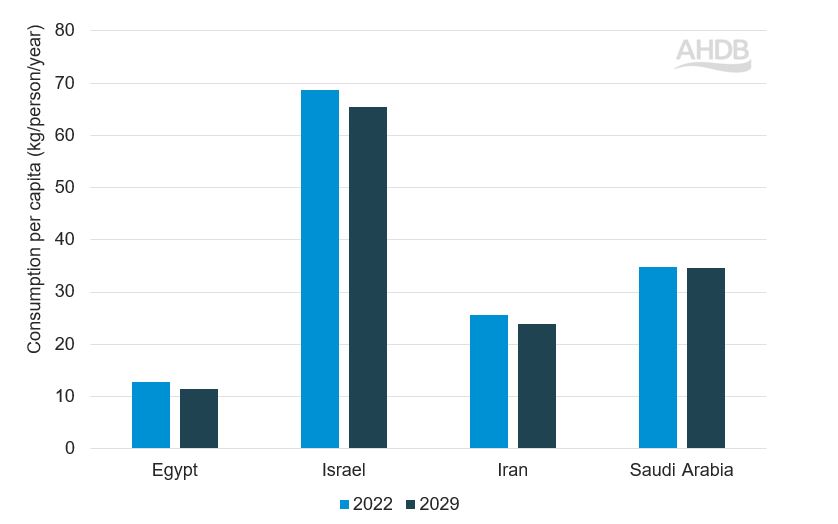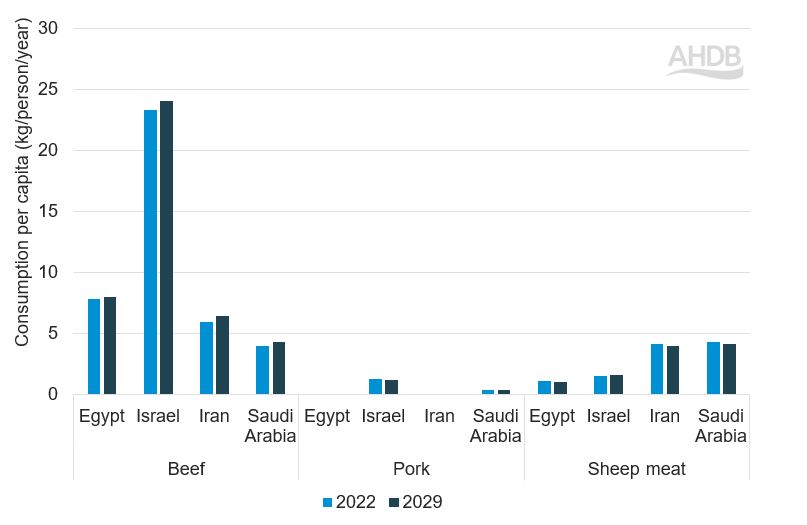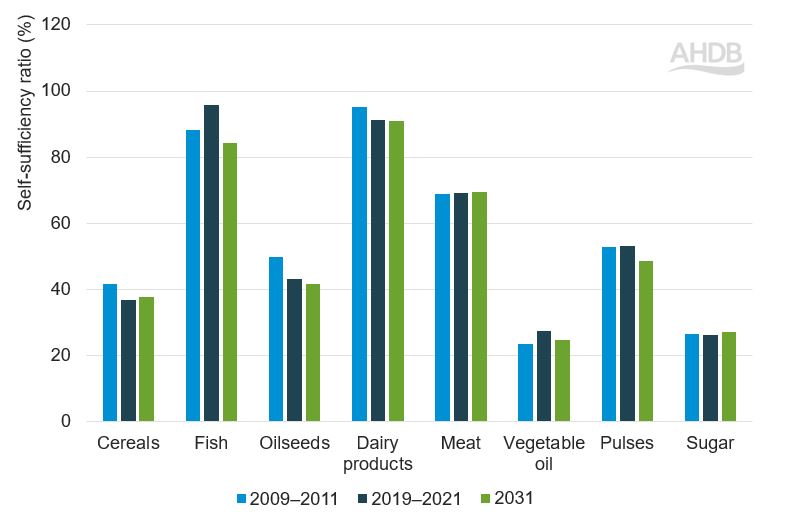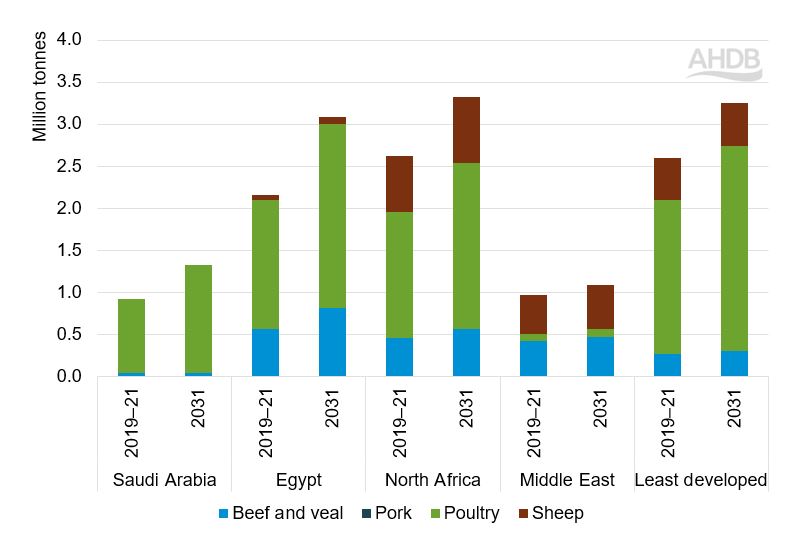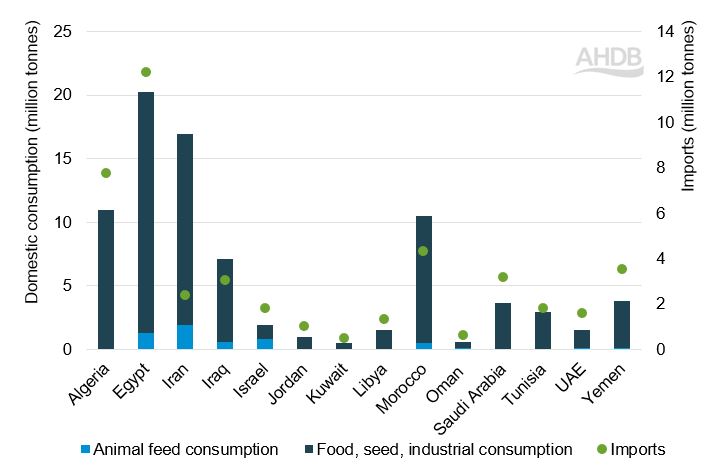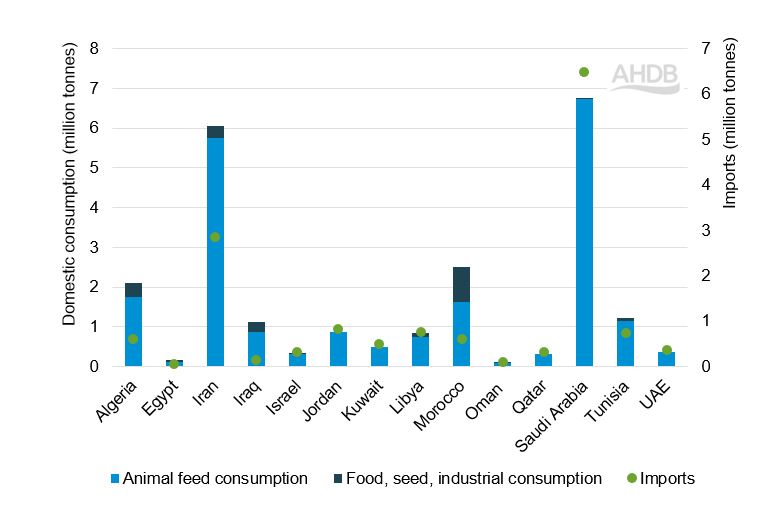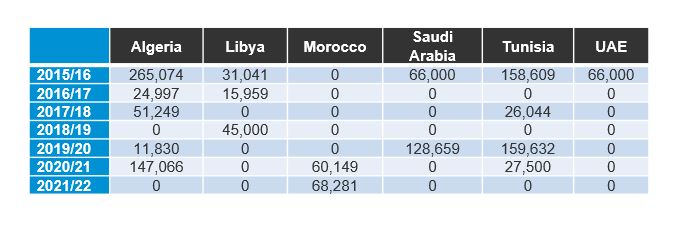- Home
- Middle East and North Africa (MENA): How much do they consume?
Middle East and North Africa (MENA): How much do they consume?
With expanding populations and changing food consumption patterns, the MENA region is a large net importer of food.
Consumption levels and trends
In the MENA region, poultry is the most consumed meat (Figure 1) followed by beef and sheep meat.
Meat consumption varies across the region (Figure 2), with the highest per capita consumption in the more affluent countries in the Gulf region.
Population growth in the region is estimated at 20% over the next ten years (second only to Sub-Saharan Africa), with the population expected to exceed 500 million by 2031.
The predominantly urban population will help drive the consumption of high-value products, such as meat and dairy.
Figure 1. Poultry meat consumption per capita in selected MENA countries (for which data is available)
Source: OECD/FAO
Figure 2. Red meat consumption per capita in selected MENA countries (for which data is available)
Source: OECD/FAO
MENA has a challenging food production environment and is one of the largest net food importing regions. Population growth will drive food imports even higher over the coming decade.
The region will have the world's highest per capita food imports by 2031, although the East Asia region will still exceed this in absolute volume terms.
For most commodities, self-sufficiency rates are low (Figure 3), particularly for cereals, vegetable oils and sugar.
In the Gulf region, where per capita income is highest and economic growth strongest, they are highly dependent on imported foodstuffs. Import growth will be highest in these countries.
Figure 3. Self-sufficiency ratios for key agricultural products in the MENA region
Source: OECD/FAO
Meat per capita food availability is forecast to increase by 6.1%, from 24.2 kg per person per year in 2019–2021 to 25.7 kg per person per year in 2031.
Growth in poultry meat production is highest for all meat (3.1% increase per annum), followed by bovine meat (1.6% increase per annum). Ovine production is expected to remain largely unchanged (OECD).
Figure 4. Livestock production trends in the MENA region
Source: OECD/FAO
The OECD forecasts that imports will rise for most commodities, forming a high share of the global markets for wheat (26%), sugar (22%) and maize (17%).
The region will also account for high shares in global trade for sheep meat (33%), cheese (19%) and poultry (18%) by 2031. In most instances, these shares are unchanged from their current high levels (OECD).
Sheep meat
MENA is a net importer of lamb.
Sheep meat is culturally important in MENA, associated with religious occasions and family celebrations. Lamb is considered a superior protein that is tender, juicy and tasty, making it a family favourite.
There is a large demand for mutton and lamb. Mutton is favoured in some countries, such as Oman, Saudi Arabia and Kuwait, due to taste preferences and cooking styles. Frozen mutton also goes into the catering sector in countries that have many migrant workers, where it competes with frozen bobby veal.
Most of the sheep meat market is a commodity product in carcase form. Premium lamb consumption and import demand are forecast to continue increasing, particularly in the Gulf region, driven by increasing disposable incomes, urbanisation, westernisation, young populations and large groups of wealthy expats.
Production is forecast to increase slightly from 1.7 Mt (2019–2021 average) to 1.89 Mt in 2031 (OECD).
The main supplier of sheep meat to MENA is Australia, although there is an opportunity for British lamb in the region.
Beef and veal
MENA is a net importer of beef.
Beef is a popular protein in MENA, behind chicken and fish.
Brazil and India are the main suppliers of imported beef, with a small quantity coming from the UK.
Beef import demand across the MENA region varies depending on domestic production and consumption habits.
In the Gulf region, countries like the UAE, Kuwait, Oman, Qatar and Bahrain, almost all beef consumed is imported.
In Saudi Arabia, Jordan, Egypt, Israel and Iran, over half of the beef consumed is imported. The rest comes from live imports and local production (primarily from the domestic dairy industry).
Overall, the largest boxed beef importers by volume are Egypt, the UAE, Saudi Arabia and Iran.
Beef consumption and spending across almost all MENA markets are forecast to increase. This is largely in response to increasing disposable incomes, urbanisation, changing diets, sizable wealthy expat populations, an expanding tourism sector and continued population growth.
Beef production in the region is expected to grow slightly from 1.75 (2019–2021 average) to 2.17 Mt in 2031 (OECD).
Dairy
MENA is a net importer of dairy products.
Dairy consumption is expected to grow due to rising disposable incomes, increasing population, and rising health consciousness among consumers.
Dairy products are now an important source of nutrition in the region. Overall, per capita availability for dairy is forecast to grow from 10.8 kg per person per year (2019–2021) to 11.4 kg per year by 2031 (OECD).
Figure 5. MENA dairy product imports
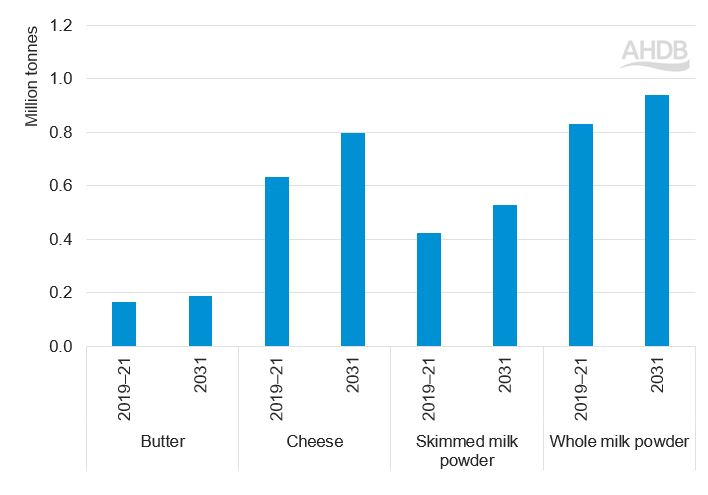
Source: OECD/FAO
Imports of cheese and skimmed milk powder into MENA are each expected to increase by 26% in 2031.
The Gulf region is driving the increase in consumption, with North Africa growing more slowly and consumption falling slightly in developing countries in 2021 (OECD).
UAE is a key market for UK dairy products, with a key area of opportunity for the dairy sector, especially for cheese, in the foodservice and hospitality industry.
The UK shipped over 2,000 t of cheese to the UAE in 2019 (UK HMRC), with new opportunities for high-value dairy cheeses.
Pork
Pork consumption per capita is negligible.
Islamic dietary laws prohibit the eating of pork. Many MENA countries restrict the importation and consumption of pork. However, in countries with relatively large non-Muslim minorities, such as Indonesia, Malaysia, Brunei, Egypt, UAE and Lebanon, pork is available in hotels, restaurants and non-Muslim supermarkets.
The rise of expat populations and tourism in the region is increasing the demand for pork, especially fresh and chilled pork.
With minimal domestic production of pork, demand is likely to be filled by imported product.
The main sources of imported pork are Denmark and the Netherlands. A small quantity is imported from the UK.
Cereals
MENA countries are heavily reliant on cereal imports.
Many MENA countries lack suitable arable land, with insufficient rainfall limiting production.
Wheat
Iran and Egypt are the leading wheat-producing countries in the MENA region, with wheat output at 14 Mt and 8.7 Mt, respectively (2017/18 – 2020/21 average). Over the same period, Morocco and Algeria produced 3.0–5.7 Mt of wheat per year.
As domestic consumption outweighs production in all MENA countries, even the leading wheat producers are net importers of wheat.
Wheat is primarily for human consumption, shown in the ‘food, seed, industrial consumption’ category in Figure 6.
Figure 6. Wheat consumption and imports for selected MENA countries (2017/18 – 2020/21 average)
Source: USDA
Egypt is the world’s largest wheat importer. In contrast, Iran is able to satisfy much of its domestic demand through its own production. Algeria’s and Morocco’s wheat imports are among the highest in the region.
On average, wheat imports from the MENA countries (Figure 6) accounted for about 24% of total global wheat imports per year (harvest years 2017/18 – 2021/22).
Russia and Ukraine are the main suppliers of wheat to Egypt, accounting for over 80% of its wheat imports. Algeria primarily sources its wheat from France and Germany, while France, Canada and Ukraine are the main providers of wheat for Morocco.
The UK has infrequent wheat exports to Algeria. By March 2022, 31.5 Kt of UK wheat had been sent to Algeria during the 2022/23 cropping year. There were no exports of UK wheat to Algeria in 2021/22 and 2020/21, but in 2019/20, 95 Kt were exported. This followed a two-year hiatus from when over 200 Kt were exported in 2016. The last time the UK shipped wheat to Morocco was in 2016/17 (9.8 Kt).
The OECD forecasts that Egypt’s consumption of wheat will increase, and, in general, the MENA region is expected to continue having a high per capita consumption of wheat.
Barley
Iran produces the most barley in the MENA region (over 3 Mt per year, based on 2017/18 – 2021/22 average). Over the same period, Morocco, Algeria and Iraq produced an average of 1–2 Mt per year.
MENA countries are also net importers of barley, with Saudi Arabia importing the highest amounts (Figure 7).
Figure 7. Barley consumption and imports for selected MENA countries (2017/18 – 2020/21 average)
Source: USDA
Barley food, seed and industrial consumption is relatively limited, mainly due to minimal demand from the brewing sector in Muslim countries. However, some brands are brewed in Morocco.
Russia, Ukraine and Kazakhstan are the main suppliers to Iran. The EU is the main supplier of barley to Algeria and Morocco.
Table 1 shows recent UK barley exports to selected MENA countries. Algeria and Tunisia have been the most frequent export destinations, with more sporadic shipments to other countries.
Table 1. UK barley exports to selected MENA countries
Source: HMRC
In MENA, poultry meat and beef production are expected to increase by 3.1% and 1.6%, respectively, per year over the next decade. This will increase the demand for feed barley and the requirement for imports.
Continue reading about the MENA market
Market access and barriers to trade


